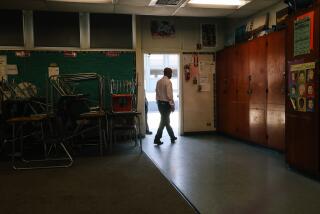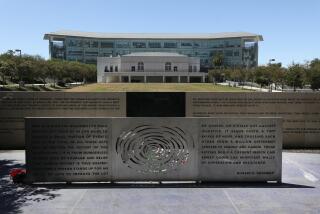Governor Urges $4-Billion Plan to Aid Schools
- Share via
SACRAMENTO — Gov. George Deukmejian, reversing a position he took five months ago, on Saturday proposed a five-year, $4-billion program to relieve the severe school overcrowding problems that plague many parts of California.
“Many areas of our state are growing fast, and they’re running out of classroom space,” the governor said in his weekly radio talk.
Overcrowding is at its worst in Los Angeles, where 125,000 students already attend year-round schools and another 33,000 are bused away from overcrowded areas. Last week, the school board agreed to begin phasing in more year-round schools, starting in 1987. However, the problem is also serious in many rapidly growing suburban school districts, where Republican voters and officials have been pressing the governor for help.
Money From Bonds
Much of the money to build new schools, and renovate existing ones, would come from two statewide $800-million bond issues Deukmejian said he would support--one next November and a second in November, 1988.
Additional money would come from the state’s tidelands oil revenues, although the governor did not mention the fact that he deferred spending $150 million in tidelands money in his 1986-87 budget on the grounds that school districts could not spend the money fast enough.
Deukmejian said the state would provide 75% of the cost of new school construction, requiring local school districts to come up with the rest.
He also urged that builder fees, which now are used to finance new schools in many fast-growing communities, be capped at $2,000 per housing unit so that they do not push housing prices beyond the range of many potential buyers.
These fees now run as high as $6,300 per housing unit in some parts of Orange and San Diego counties.
Many of the ideas in the Deukmejian program were included in a bill the Legislature passed last year, after great effort, and which the governor then vetoed.
The governor said he vetoed the bill because he was not sure how serious the problem was and because the package was too expensive. But others believe that the bill was rejected because it would have cost the state general fund $250 million the first year, $500 million the second and $750 million a year thereafter.
‘I’m Disappointed’
“I’m flattered that the governor is so married to the concepts that were in my bill,” state Sen. Leroy Greene (D-Carmichael), principal author of last year’s legislation, said Saturday, “but I’m disappointed that he didn’t see fit to sign it when it had my name on it.”
The proposals Deukmejian made Saturday will be embodied in legislation to be carried by Sen. John Seymour (R-Anaheim). Many observers in the state capital believe, however, that it will be difficult to get bipartisan agreement on a major school construction bill in a gubernatorial election year because neither party will want the other to take credit for solving the problem.
After the governor vetoed last year’s bill, his office conducted a study and concluded that the state needs $2.8 billion for new schools, another $1 billion to rehabilitate existing structures and $400 million to $500 million for air conditioning and insulation that would allow schools to operate year-round.
Major Elements
Although some details of the Deukmejian programs must still be worked out, these are the major elements; some were described in the governor’s talk and others outlined in interviews:
- $1.6 billion would come from the two proposed bond issues, if a majority of the state’s voters approve them next November and again in 1988.
- Another $150 million a year is to come from tidelands oil revenue, beginning in the 1987-88 budget year and continuing until 1990-91. However, falling world oil prices make that an uncertain source of income.
- Local school districts must come up with 25% of new construction costs, although the state will foot the entire bill for renovation.
The governor called this a “school construction partnership program,” but Greene said it was unrealistic to expect local districts to pay 25% of new construction costs because “many districts have no source for the local money except developer fees,” which the Deukmejian plan would limit.
Some Flexibility
Earlier in the week, William L. Cunningham, the governor’s education adviser, said the 25% was “flexible” and that districts unable to generate that much still would be eligible for state construction money. However, Deukmejian did not mention this in his talk.
- Developer fees would be capped at $2,000 per housing unit but could be applied to commercial, as well as residential, construction. Agreements between school districts and developers would have to be approved by either the local City Council or the county Board of Supervisors.
- Financial incentives would be offered to encourage school districts to adopt the year-round calendar. Currently, the state provides a $25-per-student incentive, and Cunningham said the Administration was “talking about” payments of $50 per elementary school pupil and $75 for a high school student.
However, Harry Handler, superintendent of the Los Angeles Unified School District, has estimated that year-round schools cost an additional $150 per pupil.
- A “menu” of local programs has been suggested to make it easier for school districts to produce the required 25% of new construction costs. Chief among these is the establishment of “benefit assessment districts,” in which all property owners in a particular geographical area are assessed to pay for new schools.
Challenged in Court
However, the first such district formed in the state, in Sacramento, has been challenged in court on the grounds that it violates Proposition 13, the 1978 state constitutional amendment that limits tax increases.
Rita Walters, president of the Los Angeles Board of Education, said school districts cannot come up with 25% funding for school construction or the extra money for year-round schools that would still be needed under Deukmejian’s plan.
“I would urge him to go back and find additional money,” she said. “It is not enough. Seventy-five percent of the cost does not erect a school, and we have no taxing authority to raise the rest of the funds.”
She said the $50 and $75 state payments per pupil to encourage year-round schools “only means about one-third or one-half of the cost. . . . The governor is really not saying a great deal.”
Deukmejian’s Saturday radio talk usually is carried by 23 radio stations around the state.
However, at least one station, KFBK in Sacramento, refused to air the talk Saturday because, said News Director Tyler Cox, “the governor is now an announced candidate for reelection. . . . If I’m going to give the governor five minutes on Saturday morning, then I’m going to have to give (Democratic candidate) Tom Bradley five minutes.”
More to Read
Sign up for Essential California
The most important California stories and recommendations in your inbox every morning.
You may occasionally receive promotional content from the Los Angeles Times.










